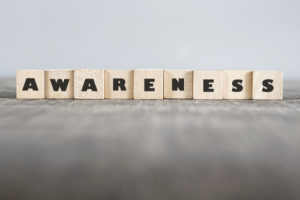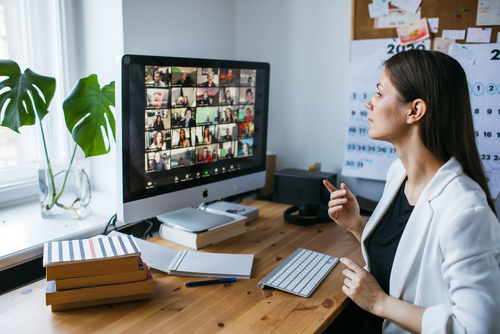
by Beth Levine | Aug 25, 2020 | preparing for a presentation, public speaking
 How many times have you said, when asked about an upcoming presentation, “Gosh, I hope it goes well!”?
How many times have you said, when asked about an upcoming presentation, “Gosh, I hope it goes well!”?
Think about that for a moment. You hope it goes well? What’s the plan that goes with that?
Hope is not a strategy. A plan to deploy your knowledge and skills is a strategy. Let’s break this down in the simplest way possible:
Your knowledge. You have a topic, and you have subject-matter expertise in that topic. That’s great, but still not enough. The next ingredient in planning your presentation is audience-centricity – taking into account your audience’s interests, needs and experience. In other words, you must organize and prepare your topic/expertise in a way that presents compelling points to your audience, and you must choreograph your time taking into account things like work-from-home distractions and screen-fatigue.
Your skills. You’re a decent presenter when you’re face to face with your audience, i.e. in the same room. More than likely, though, you’re going to need to be just as effective delivering virtually. You’ll need energy – more than usual – in your voice and body. Keep your voice energy consistently up and animated. Sit up straight and be forward in your chair. You’ll also need to employ intense eye contact – with the little green light that is the camera on your computer. Speak to the camera so that your audience sees you looking at them. And you’ll need to rehearse all of this because, in so many ways, it’s trickier than presenting face-to-face.
As we near the end of summer, and continue to settle into the new realities of how we do business, this is a good time to refresh our mindset about making effective presentations. To that end, keep in mind: Hope is not a strategy. Preparation is.
by Beth Levine | Jul 23, 2020 | preparing for a presentation, public speaking
 We don’t know what we don’t know.
We don’t know what we don’t know.
Truer words were never spoken for meetings and presentations in which the participants have never met or don’t know each other well. Call it a mindset, a motto, or simply an awareness, but it would be wise to adopt and internalize the words, “we don’t know what we don’t know.”
In response to feedback from readers after my last post, I am continuing to address implicit bias and racism in the conference room. In particular, I want to address microaggressions – what they are, how they make people feel, and how easy they are to commit unless we make every effort to err on the side of sensitivity.
Because the word “aggression” has connotations of asserting strength or power through intention, there may be some misconception about what the term “microaggression” means. An Oxford Dictionary definition describes a microaggression as “a statement, action, or incident regarded as an instance of indirect, subtle, or unintentional discrimination against members of a marginalized group such as a racial or ethnic minority.”
For our purposes here, I want to talk about microaggressions in our communications and use an example of my own offense in this regard. To that end, I need to share feedback I received recently from a woman of color who had attended one of my trainings six months ago:
She asked me if I remembered a certain story I told in which the main character was a young man from Sudan who stood out (in a Starbucks in the middle of Utah) because he was just under 7 feet tall and very dark-skinned. I remembered the story. She said she knew the story had a relevant point but, for the life of her, she couldn’t remember the point or anything else. Her brain was overtaken and paralyzed by my description of him. She said she had no reason to think my intentions were bad or racially motivated. Rather, her experiences in life had conditioned her to freeze in anticipation of the worst. A person of color listening to a white person telling a story that included mention of skin color made her feel singled-out, almost threatened, in the room. This, much to my regret, was a microaggression.
As she and I talked, I realized how little it takes to make people feel othered or even threatened. She admitted that, even while she knew the story and storyteller didn’t have racial motivations, she still froze, bracing for what a lifetime of intended and unintended offenses had prepared her for. For my part, I was contrite, full of regret, remorse, guilt, you name it.
I learned a good lesson, though, which is what I’m sharing today: Especially in rooms where I don’t know people well, and even where I do, I plan to err on the side of sensitivity. I will approach all interactions with heightened sensitivity and awareness. I will look at the faces of the people I’m communicating with and not assume anything. I will refrain from the use of examples that single out race, religion or ethnicity, and strive to tell stories that will resonate with everyone in the room. I will seek to provide context to my examples and storytelling in a way that could apply universally to anyone in the room. I think we all can do that.
After all, we don’t know what we don’t know.
by Beth Levine | Jun 20, 2020 | Just Mouthing Off, preparing for a presentation, public speaking, smartmouth talks!
 In the early ‘80s in New York City, in my very first job, my very first colleague was Barack Obama. We both had just graduated college. We both started at the company within weeks of each other. We both were assigned entry level editorial jobs, working on a series of international business newsletters and reference books, and we both reported to the same supervisor.
In the early ‘80s in New York City, in my very first job, my very first colleague was Barack Obama. We both had just graduated college. We both started at the company within weeks of each other. We both were assigned entry level editorial jobs, working on a series of international business newsletters and reference books, and we both reported to the same supervisor.
Barack was smart, smooth, and savvy then. But he was also a little aloof. While he and I were friendly colleagues, chatted daily, and periodically went out for lunch, he pretty much kept to himself otherwise. He was the only black professional at the company; the other black employees worked as secretaries or in the mailroom. It was 35 years ago. Barack’s aloofness was also, in part, his “appropriateness” at the time. He didn’t have the latitude to be the social, chatty, sometimes loud and carousing associate that I could be.
When he became President – still smart, smooth and savvy – I watched him as infuriatingly unfair things were said to and about him, insults hurled at him (and his wife), and issues he championed were trashed or quashed. I frequently remarked to myself (and to anyone nearby who would listen) how cool, calm and collected he was no matter what because he had to be, he had no choice. He was a black man, and black men cannot get angry in public, it’s too threatening to white people.
Fast forward, and here we are. Nowhere. Issues of systemic racism, implicit bias, micro and macro aggressions against people of color have made no progress … except, perhaps, the hope generated by recent protests and the renewal of active public discourse.
For those of us who are allies, but are also white, there’s a self-consciousness about our privilege and some feelings of helplessness about what to do right now – besides using our voices, voting, and whatever other forms of activism we can engage in. I, for one, can tell you I have so much heart and mind invested in helping to right the wrongs, but I am often at a loss for what, specifically, I can do to effect positive change.
I decided that, for starters, I can use my platform and communicate. I typically write this monthly piece to share tips, insights and strategies for being a better communicator and presenter. But, given current events and my despair over the dual and intertwined pandemics of COVID-19 and racism, I just couldn’t. Tips, insights and strategies seemed so trite right now … and so privileged.
Instead, I decided to write about white privilege in the conference room and how we might begin to address and redress biases and inequities in meetings and presentations.
Here’s the deal: I can be late, I can get annoyed or angry, I can tell a bad joke, I can be sassy, I can exaggerate my mannerisms, I can interrupt or talk over someone else, I can mispronounce a word or phrase, I can leave the room early — all without any consequences simply because I’m white. I’m not proud of that, but I’m aware of it. I have the same latitude to be big, take up more than my fair share of space, mess up, and even be offensive – without serious consequence – that I had in the early ‘80s. People of color haven’t and don’t have these luxuries and won’t … unless and until we force an awareness and an openness on ourselves and others. We need to take action and find ways to hold ourselves and each other accountable for the biases and inequities in conference rooms.
Here’s my starter set of suggestions:
- Check yourself before you judge or speak up;
- Check your colleagues when they judge out loud or speak up;
- Hold a larger space for people to be different/do things differently.
Those, I would say, fall under the general heading of being tolerant. Beyond just tolerance, though, how about ways to be proactive?
- Invite team members who are people of color to be lead presenters (for some reason, the lead presenter is like an NFL quarterback – more often than not, white);
- Encourage directness and polite conflict, which, to date, have been more acceptable forms of communication for white people than people of color;
- Learn about micro-aggressions and develop a system for imposing a “check” on colleagues’ responses to one another.
I don’t profess to have all the answers. I only have an awareness, an openness, and a starter set of suggested actions … so far. I’d love some input from readers. Please give this some thought and then share your ideas here. Thanks.
by Beth Levine | May 20, 2020 | public speaking
 It’s hard to think about offering advice on communication and presentation skills right now. On the one hand, it seems so trivial and insignificant given what’s going on in the world. On the other hand, as with any aspect of professionalism, we need it in order to keep business – and thereby, the economy overall – going. Or perhaps we need it even more, as we continue to present ideas and recommendations from a distance?!
It’s hard to think about offering advice on communication and presentation skills right now. On the one hand, it seems so trivial and insignificant given what’s going on in the world. On the other hand, as with any aspect of professionalism, we need it in order to keep business – and thereby, the economy overall – going. Or perhaps we need it even more, as we continue to present ideas and recommendations from a distance?!
There’s so much we don’t know at this point – including when and whether we’ll be back in conference rooms again. I have had clients whose companies are slowly returning to their office buildings tell me that, in addition to the one-way hallways, shuttered break rooms, and two-person elevator limits, there’s an indefinite moratorium on gathering in conference rooms. Wow, okay, sounds reasonable … as long as it’s temporary, right?! But it may not be temporary.
The au courant buzzwords, “new normal” and “pivot,” are not trendy for the sake of being trendy. They’re not the new “we need something disruptive” or “let’s socialize this.” They’re real, and they’re necessary. We lost our normal, and we’re not sure if or when it’s coming back, so we need to prepare for a new one. Figuring out whether our businesses or business models will suit the hypothetical or real new normal is requiring companies to at least experiment with pivoting.
So, what can a communication coach offer in this time of Corona? This month, just a couple of helpful tips about communicating and presenting effectively via the camera on your laptop or phone. Later on, I hope to be able to offer more … but for now, in-the-moment baby steps, as I’m just taking it week by week.
To that end, here are three pointers to improve your effectiveness while communicating remotely, regardless of the platform (e.g. Zoom, WebEx, Teams, etc):
1. Setup. Let’s keep this simple. Make sure your background is tidy. Make sure you’re wearing appropriate clothing all the way down to your knees or below if you might have to stand up. And most important, make sure your phone or laptop are propped up so the camera is in line with, or just above, your eyes. Also, tilt it toward you so that it’s not capturing part of the ceiling in addition to you.
2. Lighting. Natural light only. Turn off the overhead lights; they will only cast shadows and/or odd coloring on your face. Depending on the time of day and the orientation of the natural light, you might need to adjust the blinds or move closer to the screen to be seen clearly, but natural light is far better than bulbs.
3. Eye contact. You are off the hook here, there’s no need to look around at all the faces in the room! When it’s your turn to talk, the only eye contact you need to make is with the little green light of the camera. Do not look at the people stacked in the Brady Bunch boxes on the screen … or, even worse, at yourself! Look at the little green light of the camera and talk to it as if it were your best friend in the whole world.
In many respects, presenting remotely is less daunting than standing in front of a room full of people, so embrace it. And trust me, these three simple tips can make all the difference in the impression you make!
Be safe, smart, and stay well.

by Beth Levine | Apr 16, 2020 | preparing for a presentation, public speaking
One of my clients said to me recently, “The world of Zoom is like the Wild West… everyone is running in that direction, but many don’t seem to have a clue what they are doing.”
Amen sister! Zoom is a new frontier for sure, and lots of people are seeking – and others, offering – advice on how to keep virtual meetings and events interesting and engaging.

To that end, I thought about one type of meeting that could pose a real challenge online – the brainstorming session. How do you make and keep a virtual brainstorming session interesting, engaging, and inclusive?
So, at the risk of adding to the social media cacophony on effective virtual meetings and communications, here’s my one idea for Zoom brainstorming sessions (works best for teams of fewer than 10):
Time: Schedule the Zoom session for only 30 minutes.
Meeting invite: Scope out the central issue, question, idea or solution needed. Identify parameters and any specifics that brainstorming participants need to know.
Assignment: Ask participants to brainstorm on their own prior to the meeting (this works better for introverts anyway) and then to home in on their best idea and develop a 3-minute pitch around that idea.
Meeting agenda: Pitchfest! Make the Zoom session a Pitchfest, in which each participant takes no more than 3 minutes to pitch their idea and its rationale to the team. Meeting leader, be sure to time everyone!
Result: You can do an online poll afterward to rank the ideas, or you can let the ideas marinate for a while (e.g. 24 hours) and then hold a “watercooler” session via Zoom to ask questions, discuss, debate and decide. To ensure inclusivity and full engagement, make sure everyone has a chance to talk and ask questions.
If you try this, please let me know how it goes! I’d love to hear feedback!
by Beth Levine | Mar 25, 2020 | preparing for a presentation, public speaking
 The Virus. Say no more, right?
The Virus. Say no more, right?
Our lives seem to have changed almost overnight. Places of work, learning, gathering and networking are all closed, on hold, or happening virtually.
Since so many of us will be conducting business, learning, and even attending industry events online, I thought it might be the responsible thing to ditch what I was going to write about this month and turn my attention to offering tips for virtual communications.
If you are working remotely, and leading or attending meetings online or via conference call, here are some quick-hit tips for you on being an effective communicator from a distance:
Audiences need more guidance than usual. One of the things we know about audiences is that it’s a passive role to be a listener. Audiences simply won’t work very hard to figure out what a speaker is saying or what the speaker wants them to know. Even in-person audiences need constant guidance – e.g. when you’re digressing to tell a story, or when you’re moving from one point or section to another, or what your key takeaway is – so you can imagine the need for remote audiences. It’s exponentially greater. Therefore, take your audiences by the hand and walk them through every step of your meeting or presentation so they can track and follow along.
Stand, don’t sit. If you’re on a conference call, stand up to speak. Your voice energy and projection will be stronger and more commanding than when you’re sitting (and possibly leaning back in your chair). You don’t want to be the person who sounds distant and low-energy. You also don’t want to be the person whose delivery is halting and distracted-sounding … because you’re reading an email that came in while you were talking. Stand up, look away from your screen, and project.
Keep it brief, and keep it moving. Holding attention, interest, and engagement in online meetings is more challenging than when your group is gathered together around a conference room table. (It would be great if this could mean goodbye-for-now to long, tedious, rambling meetings!) If you are a meeting leader – or an assertive meeting participant – help the group keep exchanges limited to important topics and robust discussions. It’s more than fair to ask that tangents and irrelevant questions be put on hold for another time.
While all of this presents a test to our ability to focus, be present, and be concise and on point, I want to offer kudos to all of you who are doing your best to work from home and maintain some momentum in your work lives. As we all find our way through these surreal times together, I have complete faith in everyone to do what’s needed. Nevertheless, I’m here if you need me; reach out and we can set up a Zoom session!

 How many times have you said, when asked about an upcoming presentation, “Gosh, I hope it goes well!”?
How many times have you said, when asked about an upcoming presentation, “Gosh, I hope it goes well!”? 
 We don’t know what we don’t know.
We don’t know what we don’t know. In the early ‘80s in New York City, in my very first job, my very first colleague was Barack Obama. We both had just graduated college. We both started at the company within weeks of each other. We both were assigned entry level editorial jobs, working on a series of international business newsletters and reference books, and we both reported to the same supervisor.
In the early ‘80s in New York City, in my very first job, my very first colleague was Barack Obama. We both had just graduated college. We both started at the company within weeks of each other. We both were assigned entry level editorial jobs, working on a series of international business newsletters and reference books, and we both reported to the same supervisor. It’s hard to think about offering advice on communication and presentation skills right now. On the one hand, it seems so trivial and insignificant given what’s going on in the world. On the other hand, as with any aspect of professionalism, we need it in order to keep business – and thereby, the economy overall – going. Or perhaps we need it even more, as we continue to present ideas and recommendations from a distance?!
It’s hard to think about offering advice on communication and presentation skills right now. On the one hand, it seems so trivial and insignificant given what’s going on in the world. On the other hand, as with any aspect of professionalism, we need it in order to keep business – and thereby, the economy overall – going. Or perhaps we need it even more, as we continue to present ideas and recommendations from a distance?!
 The Virus. Say no more, right?
The Virus. Say no more, right? 

